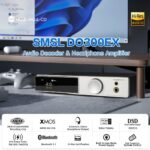So, you’ve always dreamed of having your own little sanctuary at home where you can immerse yourself in the world of music, completely undisturbed. Well, you’re in luck because we’ve got just the thing for you! In this article, we’re going to take you through the step-by-step process of creating the ultimate home listening room. From choosing the perfect location to selecting the right equipment and optimizing the acoustics, we’ve got you covered. So get ready to transform your space into a haven for music lovers and get ready to indulge in the ultimate listening experience.
Understanding the Basics of Sound
Defining sound and acoustics
When it comes to understanding the basics of sound, it’s necessary to start with the fundamentals. Sound is simply the vibration of particles that travel through a medium, such as air, water, or solids. These vibrations produce audible sensations in our ears, allowing us to perceive sound. Acoustics, on the other hand, is the study of how sound behaves in different environments and how it interacts with various surfaces and objects.
How sound travels
sound waves require a medium to travel through, and in most cases, it’s air that serves as the medium. When an object, such as a speaker, produces sound, it creates vibrations in the air particles. These vibrations then propagate as a series of compressions and rarefactions, forming sound waves. These waves travel in all directions from their source until they encounter a surface or object, which can either reflect, absorb, or transmit the sound. Understanding how sound travels is crucial in designing a listening room that optimizes sound quality.
The influence of room dimensions on sound
The dimensions of a room play a significant role in how sound behaves within that space. Certain room dimensions can result in specific resonances or standing waves, which can lead to uneven frequency response and unpleasant listening experiences. For example, a room with parallel walls may create standing waves at certain frequencies, causing some notes to sound louder or softer than intended. Similarly, square or rectangular rooms can produce resonances that emphasize specific frequencies. Understanding the influence of room dimensions on sound can guide us in making informed decisions when selecting a room for our home listening space.
Assessing Your Current Room Acoustics
Common issues with home room acoustics
Before diving into creating the ultimate listening room, it’s essential to assess the current acoustics of your room. Common issues with home room acoustics can include echoes, unwanted reflections, and uneven sound distribution. Echoes occur when sound reflects off hard surfaces, causing a delay between the direct sound and its reflections. Unwanted reflections can lead to a muddled or boomy sound, and uneven sound distribution can result in certain areas of the room sounding louder or quieter than others. Identifying these issues is the first step in improving your listening experience.
Use of sound measuring tools
To assess the current acoustics of your room accurately, sound measuring tools can be incredibly helpful. Tools such as decibel meters, sound level analyzers, and frequency response analyzers can provide measurements and visual representations of the sound in your room. These tools allow you to identify specific frequencies that may be problematic and help you determine the effectiveness of any acoustic treatments or changes you make to the room.
Identifying echoes, sound levels, and reverb times
When assessing your room acoustics, it’s essential to focus on three key aspects: echoes, sound levels, and reverb times. Echoes can be identified by clapping your hands and listening for a distinct repetition of the sound. Sound levels can be measured using a decibel meter and should be within a comfortable range for listening. Reverb times, on the other hand, refer to the duration it takes for sound to decay by 60dB after the sound source stops. By identifying these factors, you can address any issues that may be affecting the quality of sound in your listening room.
Choosing the Right Room
Room size and shape considerations
When selecting the right room for your listening space, room size and shape are crucial factors to consider. The ideal room size will depend on several factors, including your listening preferences, the equipment you plan to install, and the available space. A room that is too small may result in a cramped listening experience, while a room that is too large may suffer from sound reflections and diminished sound quality. Room shape is equally important, as certain shapes can create standing waves or resonances that affect sound reproduction. Ideally, a listening room with irregular surfaces and non-parallel walls will help minimize unwanted reflections and resonances.
Avoiding places with lots of windows or doors
Windows and doors can significantly impact the acoustics of your listening room. Large windows can introduce unwanted reflections and sound leakage, while doors can cause sound leaks and disrupt the desired sound isolation. Ideally, it is best to choose a room with minimal windows and doors. However, if your chosen room has these features, there are ways to minimize their impact, such as using heavy curtains or installing soundproofing materials around windows and doors.
Adapting existing rooms vs. building a new one
When it comes to creating the ultimate listening room, you have the option to adapt an existing room or build a new one. Adapting an existing room can be a more budget-friendly option and may only require acoustic treatments and modifications to optimize the sound quality. However, if you have the resources and flexibility, building a new room specifically designed for optimal acoustics can provide unparalleled sound reproduction. This can involve designing and constructing walls, ceilings, and floors with techniques that minimize sound transmission and control acoustic reflections.
Planning Your Listening Room Layout
Positioning speakers for optimal sound
Once you have chosen the right room, planning the layout of your listening space is crucial for achieving optimal sound. When positioning your speakers, consider the stereo imaging and soundstage you want to achieve. The speakers should be placed at an equal distance from the listening position and angled slightly inward to create a centered sound image. Additionally, it’s essential to position the speakers away from walls to reduce unwanted reflections and bass buildup. Experimenting with speaker placement and considering the manufacturer’s recommendations can help achieve the best sound reproduction.
Seating arrangement for the best listening experience
In addition to speaker placement, the seating arrangement also plays a significant role in the listening experience. Ideally, the listening position should be located at the focal point of the room, where the speakers’ sound waves converge. This position should also avoid any room modes or standing wave issues that may cause uneven bass response. Placing the listening position slightly away from walls can help reduce unwanted reflections, providing a more balanced and immersive listening experience.
Arrangement of other furnishings and decors
Beyond speaker and seating placement, the arrangement of other furnishings and decors in your listening room can also impact the acoustics. Large furniture, such as bookshelves, cabinets, or sofas, can act as diffusers, scattering sound waves and reducing reflections. Similarly, wall hangings, curtains, and carpets can help dampen sound and absorb unwanted echoes. Finding a balance between aesthetics and acoustics is crucial in creating a listening room that is both visually appealing and acoustically optimized.
Soundproofing the Room
The need for soundproofing
Soundproofing your listening room is vital to ensure that sound does not escape the room and disturb others in your home, as well as to prevent external noise from interfering with your listening experience. Soundproofing helps create a controlled acoustic environment, allowing you to fully immerse yourself in the music without distractions. Additionally, proper soundproofing can prevent sound leakage into neighboring rooms, ensuring that your audio system’s full potential is realized.
Different methods of soundproofing
There are several methods of soundproofing available, each with its advantages and considerations. These methods include adding mass to walls, ceilings, and floors; decoupling structures to reduce sound transmission; using acoustic sealants and gaskets to seal air gaps; and installing soundproofing materials such as acoustic panels, foam, or curtains. The choice of method will depend on the specific requirements of your listening room and the level of soundproofing desired.
Choosing and installing soundproofing materials
Selecting the right soundproofing materials is crucial in achieving effective sound isolation in your listening room. Acoustic panels and foam can absorb and diffuse sound, reducing reverberation and minimizing reflections. Thick curtains or blackout blinds can help block external noise and create a more controlled listening environment. It’s important to ensure that these materials are properly installed, covering as much surface area as possible, and addressing any potential sound leakage points, such as gaps around doors or windows.
Enhancing the Room Acoustics
Role of diffusers and absorbers
To further enhance the acoustics of your listening room, diffusers and absorbers play a vital role. Diffusers help scatter sound waves, preventing strong reflections and creating a sense of spaciousness and depth. Absorbers, on the other hand, absorb sound energy, reducing echoes and reverb times, resulting in a cleaner and clearer sound. By strategically placing diffusers and absorbers in your listening room, you can improve the overall balance, clarity, and immersion of the sound.
Where to place these acoustic enhancement tools
The placement of diffusers and absorbers in your listening room is crucial for optimal acoustic enhancement. Diffusers are typically placed on walls facing the listener and where strong reflections occur. They can be installed at various heights, allowing for more effective scattering of sound waves. Absorbers, on the other hand, are best placed on surfaces that reflect sound, such as walls, ceilings, and even on the backside of doors. By strategically placing these tools in your room, you can control reflections, minimize standing waves, and create a more accurate listening environment.
How to properly install them
Proper installation of diffusers and absorbers is essential in maximizing their effectiveness. Diffusers should be securely mounted on walls and positioned at the right height and angle to scatter sound waves effectively. Absorbers can be installed using adhesive or mounted on frames, depending on the type of material used. It’s important to ensure that the thickness and density of the absorber materials are appropriate for the frequencies you want to absorb. Proper installation of these acoustic enhancement tools will help achieve the desired sound balance and clarity in your listening room.
Choosing Your Audio Equipment
How different pieces of audio equipment influence sound
The audio equipment you choose for your listening room can significantly influence the quality and accuracy of the sound. Each piece of audio equipment, such as the amplifier, speakers, and source components, contributes to the overall sound reproduction. The quality of these components, their compatibility with each other, and their ability to reproduce sound within a specific frequency range will impact the overall listening experience.
What to look for in a sound system
When selecting a sound system for your listening room, there are several factors to consider. First and foremost, look for components that provide accurate and neutral sound reproduction. Consider the power rating of the amplifier, the sensitivity and frequency response of the speakers, and the compatibility with your audio sources. It’s also important to consider the room size and layout when choosing the appropriate speaker size and configuration. Additionally, assessing the build quality and reputation of the audio equipment manufacturers can help ensure the longevity and reliability of your system.
Recommended audio equipment for a home listening room
While the choice of audio equipment ultimately depends on personal preferences and budget, there are some highly recommended options for a home listening room. For amplifiers, brands like Marantz, NAD, and Cambridge Audio offer high-quality options that provide clean and powerful sound reproduction. Speaker brands such as KEF, Bowers & Wilkins, and Monitor Audio are known for their exceptional audio performance and build quality. Additionally, renowned audio source components, such as turntables from Rega or digital sources from Bluesound, can provide a rich and immersive listening experience.
Setting Up Your Audio Equipment
Placing speakers for the best sound spread
Speaker placement is crucial in optimizing sound spread and achieving a balanced listening experience. Ideally, speakers should be positioned symmetrically in relation to the listening position. They should also be placed away from walls to minimize unwanted reflections and bass buildup. Experiment with speaker placement, making small adjustments to find the sweet spot where the soundstage is the most defined and immersive.
Positioning audio sources and sound controls
In addition to speaker placement, the positioning of audio sources and sound controls is equally important. Sources such as amplifiers, turntables, or media players should be placed within easy reach, allowing for convenient operation and accessibility. Additionally, sound control devices, such as equalizers or digital signal processors, should be positioned for easy adjustments while seated in the listening position. Strive for a setup that minimizes cable clutter and promotes ease of use.
Correctly wiring your sound system
Proper wiring of your sound system is crucial in achieving optimal signal transmission and audio quality. Use high-quality cables that are appropriately sized, correctly terminated, and shielded to reduce interference. When connecting speakers, ensure that the positive and negative terminals are correctly matched to maintain proper phase alignment. Similarly, when wiring audio sources and amplifier inputs, follow the manufacturer’s recommendations for optimal signal flow and connection integrity. Taking the time to wire your sound system correctly will result in improved audio performance and a more enjoyable listening experience.
Room Calibration for Optimal Sound
How room calibration works
Room calibration is the process of fine-tuning your audio system and adjusting its output to compensate for the room’s acoustics. It involves measuring the frequency response and characteristics of the room and using that information to make precise adjustments to the audio system’s settings. Room calibration systems utilize a combination of microphones, software, and audio test signals to accurately analyze the room’s acoustics and optimize the sound reproduction.
Tools needed for room calibration
To perform room calibration, you will need specific tools and equipment. This typically includes a measurement microphone, a computer or specialized room calibration hardware, and software that can analyze and adjust the audio system’s settings. Some popular room calibration systems include Dirac Live, Trinnov Audio, and Audyssey. These tools provide automated room correction algorithms that can significantly improve the overall sound quality and sonic performance in any listening room.
Steps in calibrating your audio room
The process of calibrating your audio room typically involves the following steps:
- Setting up the measurement microphone at the desired listening position.
- Running the room calibration software and performing the initial measurement sweep.
- Analyzing the measurement results to identify any irregularities or resonant peaks in the frequency response.
- Utilizing the room calibration software to apply adjustments to the audio system’s settings, such as equalization, time alignment, or level matching.
- Iterating the measurement and adjustment process until the desired sound quality and accuracy are achieved.
By following these steps and taking the time to perform room calibration, you can fine-tune your audio system to ensure optimal sound reproduction and a more immersive listening experience.
Enhancing Your Listening Room Experience Further
Factors that can enhance or diminish audio quality
While creating the ultimate home listening room involves careful consideration of room acoustics and audio equipment, there are additional factors that can enhance or diminish overall audio quality. Factors such as room temperature and humidity can affect the performance of audio equipment and impact sound reproduction. Additionally, ambient noise from external sources, such as HVAC systems or street traffic, can introduce unwanted distractions and diminish the listening experience. Paying attention to these factors and taking steps to mitigate their impact can further elevate your listening room experience.
Investing in high-end audio equipment
For those seeking the ultimate audio experience, investing in high-end audio equipment can significantly enhance the sound reproduction in your listening room. High-end audio equipment often boasts superior construction, meticulous engineering, and advanced technologies, resulting in exceptional sound quality and accuracy. Brands such as McIntosh, Focal, and Wilson Audio are renowned for their high-end offerings that deliver unparalleled audio performance. However, it’s important to note that the investment required for these systems can be substantial, so careful consideration of budget and priorities is necessary.
New technologies for home listening rooms
The world of audio technology is constantly evolving, introducing new innovations that can transform the home listening experience. From wireless streaming solutions to immersive surround sound formats, new technologies offer exciting possibilities for enhancing your listening room. Wireless multi-room audio systems, such as Sonos or Bluesound, allow you to effortlessly enjoy high-quality audio in multiple rooms throughout your home. Immersive audio formats, such as Dolby Atmos, bring a three-dimensional sound experience to your listening room, enveloping you in a truly captivating audio environment. Exploring these new technologies can open up a world of possibilities for taking your home listening room to the next level.
In conclusion, building the ultimate home listening room requires a thoughtful approach that encompasses understanding the basics of sound, assessing the current acoustics, choosing the right room, planning the layout, soundproofing, enhancing the acoustics, selecting audio equipment, setting up the audio equipment, calibrating the room, and considering further enhancements. By following this step-by-step guide and incorporating your personal preferences, you can create a listening room that offers an unparalleled audio experience and a true sonic oasis within your home.










